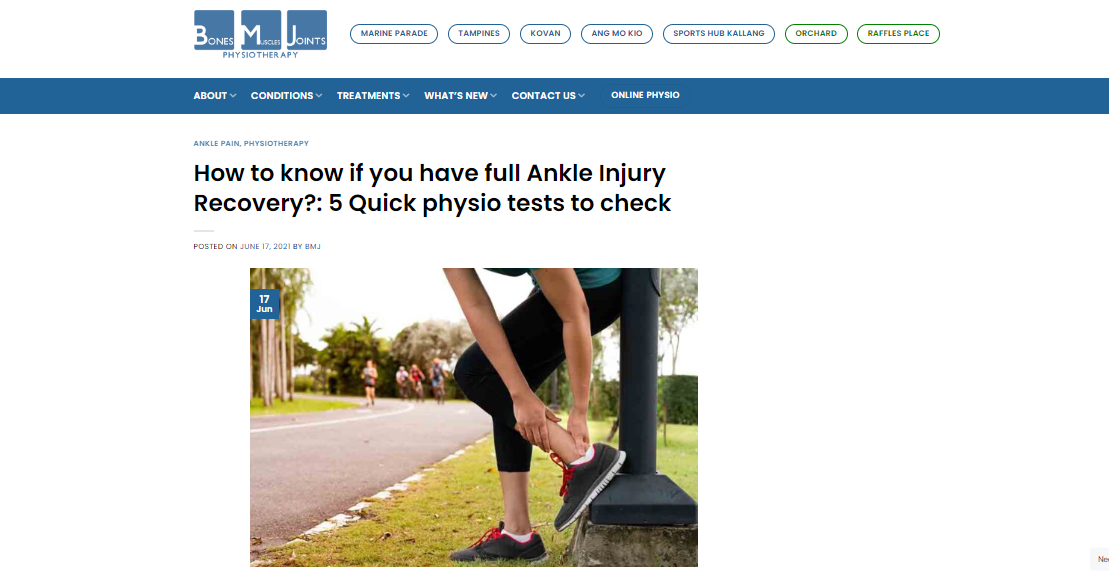
Are you eager for quick ankle injury recovery? Discover these short self-tests to assess your full recovery from ankle sprain recovery and ensure a seamless return to physical activities.
About BMJ Therapy:
Ankle injuries, particularly sprains, are commonplace and often bear the risk of recurrence. Inadequate recovery can result in prolonged discomfort and hinder participation in physical activities. Achieving a complete ankle injury recovery involves regaining full function, encompassing movement, strength, and control. Research underscores the significance of restoring dorsiflexion, a specific ankle movement, to reduce the likelihood of future sprains. An unstable ankle is a potential hazard for new injuries. In this article, we present five quick self-tests designed to gauge the extent of ankle recovery and determine readiness to resume activities post-injury. For precise guidance, how to heal sprained ankle fast, consult a physiotherapist when performing these tests. Our specialized sessions for sprained ankle recovery treatment focus on restoring range of motion and ensuring optimal readiness for sports and physical activities.
Welcome to the Comprehensive Guide for sprain ankle recovery! Tailored to assist you in effectively managing and accelerating the healing process of a how to heal a sprained ankle fast in 2 days, this guide offers expert-recommended strategies and exercises. Ankle sprains, common injuries that can impede mobility and cause discomfort, fully recovery, can be addressed with the methods outlined here. By following these strategies and exercises, you can expedite recovery and restore normal dorsiflexion range of motion (ROM) in just two days.
Ankle injuries, especially sprains, can be not only painful but also present a risk of recurrence if not properly addressed. Inadequate recovery may lead to prolonged discomfort and hinder participation in physical activities, emphasizing the critical need for a comprehensive approach to ankle injury recovery. This article serves as a guide to assess your recovery progress through five quick physio tests and provides expert-recommended strategies for swift healing.
1. Dorsiflexion Assessment:
Research indicates that insufficient recovery of dorsiflexion, a specific ankle movement, can increase the likelihood of subsequent sprains. To evaluate your dorsiflexion, sit on the edge of a surface with your feet flat on the floor. Attempt to bring your toes towards your shin. Limited movement or discomfort may suggest incomplete recovery.
2. Balance and Stability Test:
An unstable ankle is more susceptible to new injuries. Stand on one foot for 30 seconds and then switch. Any difficulty maintaining balance may indicate lingering instability. Repeat this test with your eyes closed for an added challenge.
3. Resistance Exercise Readiness:
Gradually reintroduce resistance exercises to assess your ankle's strength. Perform exercises like calf raises and resistance band exercises. Pay attention to any discomfort, weakness, or imbalance during these activities.
4. Range of Motion Check:
Gently move your ankle in all directions to assess its range of motion. Ensure smooth and pain-free movement in flexion, extension, inversion, and eversion. Any restrictions or discomfort may indicate incomplete recovery.
5. Functional Movement Evaluation:
Simulate activities related to your daily or sports routine, such as walking, jogging, or pivoting. Evaluate your ankle's response to these movements. Any pain or hesitation may suggest the need for further recovery.
Consultation with a Physiotherapist:
While these tests offer a self-assessment, it is crucial to consult a physiotherapist for precise guidance. They can provide personalized advice based on your specific condition and ensure accurate testing techniques.
Specialized Sessions for Sprained Ankle Treatment:
At BMJ Therapy, our specialized sessions for sprained ankle treatment focus on restoring range of motion and ensuring optimal readiness for sports and physical activities. Our expert physiotherapists tailor treatment plans to address individual needs, facilitating a comprehensive and effective recovery.
Conclusion:
Incorporating these quick physio tests into your recovery journey can help you gauge the extent of your ankle's recovery and determine your readiness to resume activities post-injury. For a fully recovered and resilient ankle, consult with a physiotherapist and explore the specialized sessions offered at BMJ Therapy. Don't let a sprained ankle hold you back—learn more about accelerating your recovery and returning to full functionality by clicking here.
Social Media:
https://www.facebook.com/BMJTHERAPY/
https://www.instagram.com/bmjphysiotherapy/

0 Comments